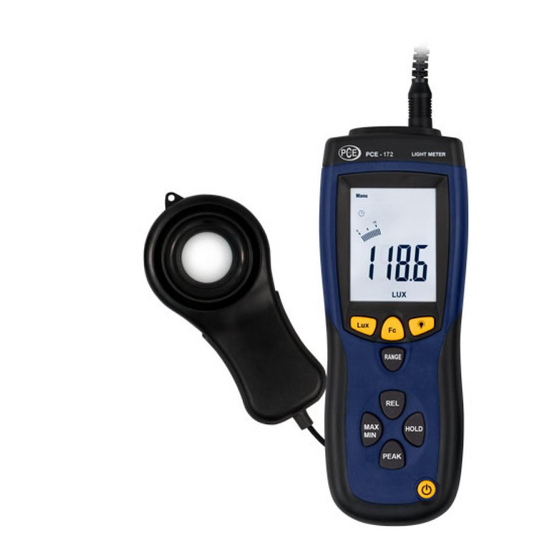
Table of Contents
Advertisement
Quick Links
Advertisement
Table of Contents

Summary of Contents for PCE Instruments PCE-172
- Page 1 Manual DIGITAL ILLUMINANCE METER PCE-172...
- Page 2 CONTENT INSTRUCTION ......................... 3 FEATURES ........................3 SPECIFICATIONS ......................3 NAME OF PARTS AND POSITIONS ................4 OPERATING INSTRUCTIONS ..................4 BATTERY CHECK-UP & REPLACEMENT ..............4 SPECTRAL SENSITIVITY CHARACTERISTIC ............... 5 MAINTENANCE ....................... 5 RECOMMENDED ILLUMINATION .................. 5...
- Page 3 1. INSTRUCTION The digital illuminance meter is a precision instrument used to measure illuminance (lux, footcandle) in the field. It is meet CIE photopic spectral response. It is fully cosine corrected for the angular incidence of light. The illuminance meter is compact, tough and easy to handle owing to its constrution. The light sensitive component used in the meter is a very stable, long-life silicon photo diode and spectral response filter.
- Page 4 4. NAME OF PARTS AND POSITIONS 1. LCD Display: 3-3/4 digit displays with a maximum reading of 3999, and the indicating signs measured values, unit function symbols and decimal points etc are display. 2. Lux key: Pressing the lux key selects taking measurement of illuminance in lux scale 3.
- Page 5 3. Disconnect the battery from the instrument and replace it with a standard 9V battery and go for the cover. 7. SPECTRAL SENSITIVITY CHARACTERISTIC To the detector, the applied photo diode with filters makes the spectral sensitivity characteristic almost meet C.I.E.(INTERNATIONAL COMMISSION ON ILLUMINATION) Photopic curve V (λ) as the following chart described.
- Page 6 NOTE: "This instrument doesn’t have ATEX protection, so it should not be used in potentially explosive atmospheres (powder, flammable gases)."...















Need help?
Do you have a question about the PCE-172 and is the answer not in the manual?
Questions and answers